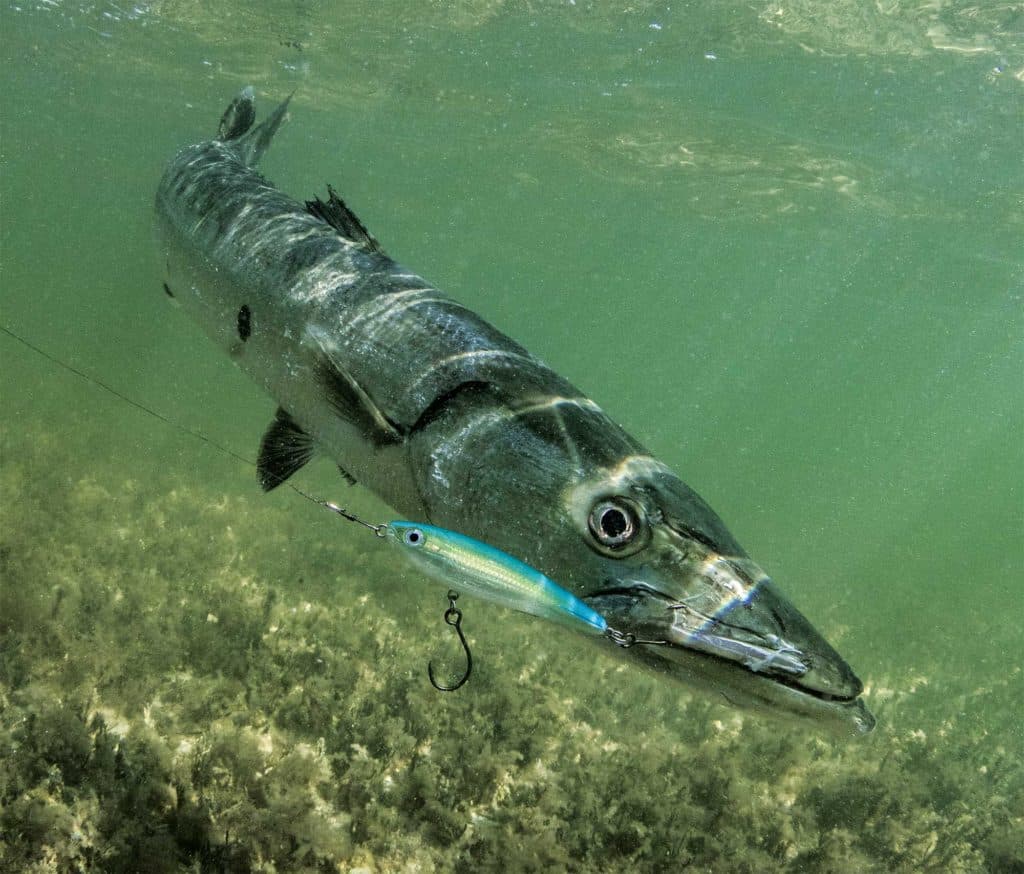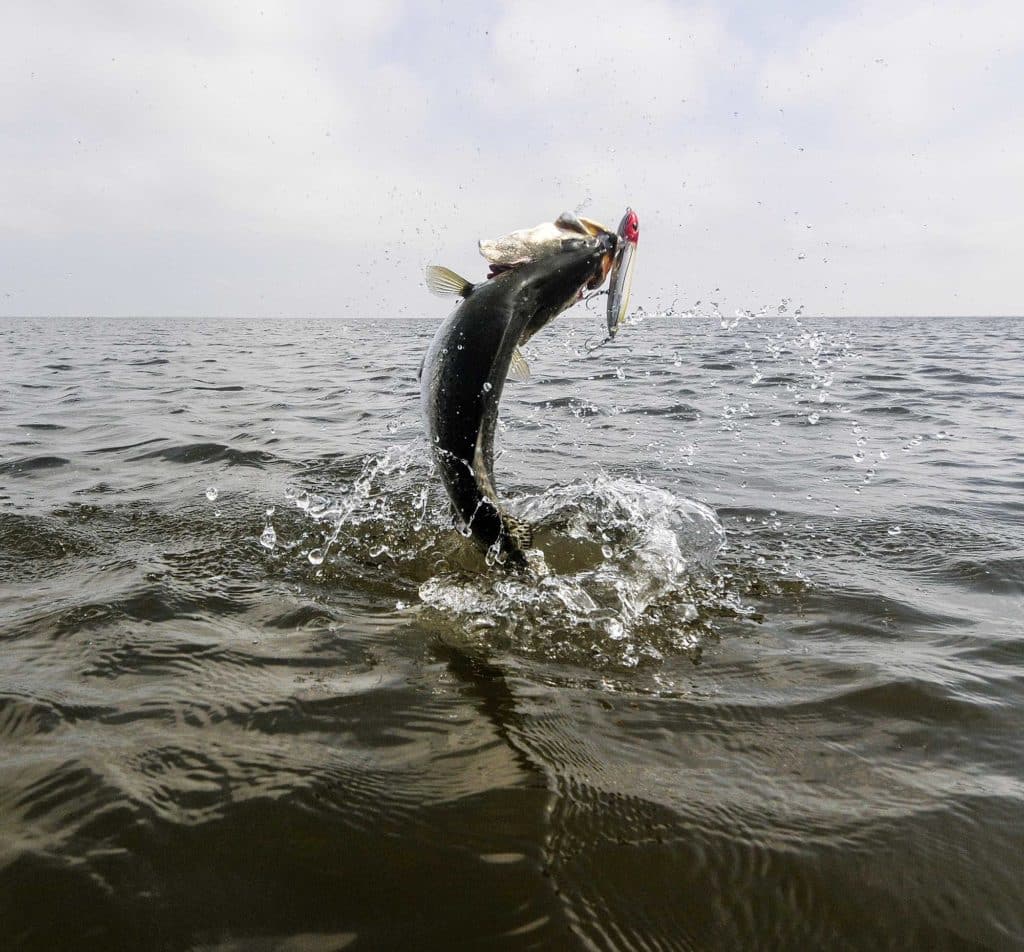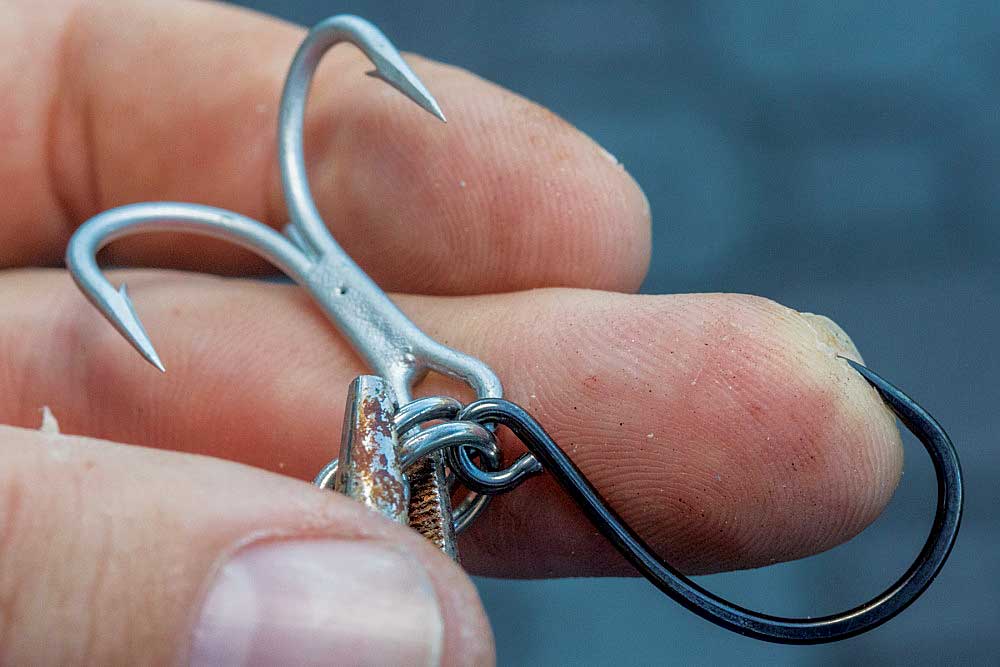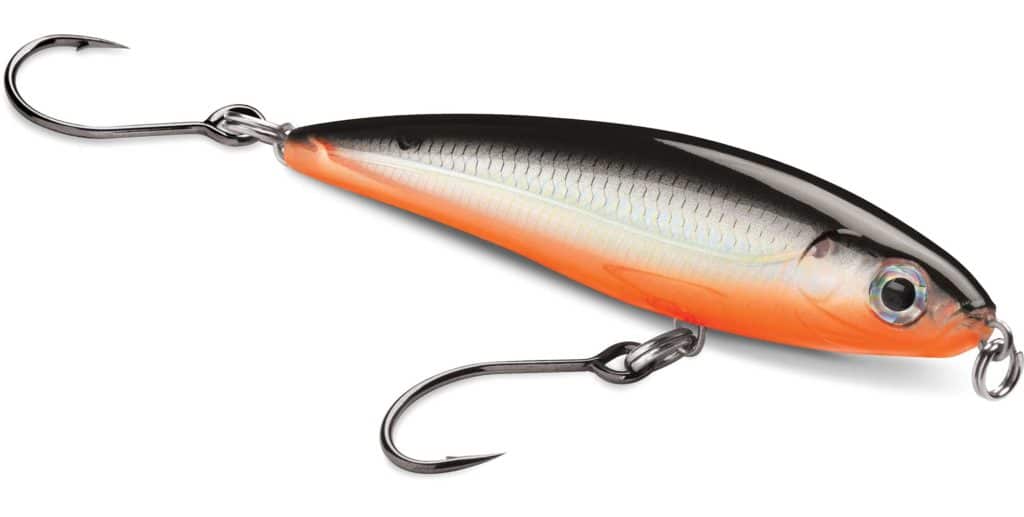
A topwater plug, jerkbait or diving lure with multiple treble hooks commonly snags fish in several anatomical locations: mouth, side, belly, tail. That keeps the fish hooked, but it certainly hampers a quick release.
Thoughtful captains who release all or most of their fish usually replace treble hooks with single hooks. Of course, single hooks don’t offer as high a hookup rate as trebles, in part because of basic math: Replacing two trebles with two single hooks means using only two hook points instead of six. But removing single hooks from a fish is easier and faster.
“If I know I’m going to catch-and-release fish, I don’t want a treble on my lures,” says Capt. Glyn Austin (goingcoastalcharters.com) of Palm Bay, Florida, who fishes the Indian River for snook, redfish, seatrout and tarpon, and the waters offshore of Sebastian Inlet for sharks and big jack crevalle. “Especially an aggressive fish, they’ll suck in a lure and die.”
Texas captain Chad Kinney agrees. “If I’m going out for fun, I don’t want to whack any fish,” says Kinney (bammbammfishing.com), who targets seatrout and redfish in the Lower Laguna Madre out of Port Mansfield. “I’ll replace the trebles right off the bat.”
The main reason to switch from a treble to a single hook is to do less damage to the fish, adds Capt. Matt Williams (missjudycharters.com), who fishes lures with single hooks whether he’s targeting seatrout, tarpon, striped bass and redfish out of his home base in Savannah, Georgia, or silver salmon in Alaska. “If you’ve already caught your limit, that would be a good time to switch over to single hooks.”

Single Advantages
In addition to protecting fish, most single hooks prove stronger than treble hooks, which can be straightened or mashed by big fish. “Many lure-makers use light treble hooks for the best action,” says Austin, who replaces those trebles with heavier, thicker single hooks. “If you’ve got a big snook, redfish, trout or jack, the fish might mangle the treble hooks on a lot of inshore lures. I’ve had hooks destroyed after catching one fish.”
Williams points out that pliers easily damage treble hooks during hook removal. “It doesn’t matter how careful you are, you’ll bend the hook.” He adds that single hooks don’t horribly tangle in a landing net like trebles.
“I’ve also noticed you don’t lose as many fish with a single hook. They don’t tend to come off,” he says, noting that because a single hook features a wider gap than the hooks on a comparably sized treble, the single better penetrates the fish’s mouth.

Changing Hooks
To change out hooks, captains use split-ring pliers to first spread open the ring that attaches the hook to the plug. Austin carries two sizes of split-ring pliers in his boat so he can work on the big topwater plugs that he throws for sharks as well as his smaller inshore lures.
“You’ve got to have a good pair of split-ring pliers,” Austin says. “Big treble hooks can be hard to remove, and I can promise you that you won’t be opening split rings with your fingernails or a knife.”
With or without split-ring pliers, “there’s a pretty good chance you’re going to hook yourself,” says Williams, who uses a second pair of pliers — needle-nose style — to hold and remove a treble. “I basically use them like two hands so I don’t really have to handle the hook at all.”
Some anglers attach a second split ring to the one that came with the lure, and then attach a single hook to the supplemental ring. That’s commonly done on high-end custom lures that feature hook hangers perpendicular to the lure body. Austin, a Rapala pro staffer, uses only the original split ring “because that [second ring] is just another connection that could fail.”
Read Next: Top Hook Modifications for Lures
Replacement single hooks vary in style and size depending on the lure and your target fish. One of Kinney’s favorite topwater lures, a Heddon One Knocker Spook, comes with two No. 2 treble hooks. He also fishes a Super Spook, which, depending on its size, sports two or three No. 4 trebles. He replaces the trebles with Gamakatsu Octopus hooks ranging in size from 2/0 to 4/0.
“The size of the hook depends on what we’re targeting,” Kinney says. “I try to stay as small as possible and still get a good hook-set.”
Austin chooses the biggest single hooks he can use without impeding the lure’s action, which is something he determined through trial and error. A single hook that’s too heavy or too big can make a suspending lure sink too fast.
At times, Austin attaches one single hook to the back eye on the lure, which usually results in better lure action and makes for quicker releases. “It’s typically when you’re fishing for school fish like bluefish and jacks, as well as sharks, that you want to be able to unhook easily.”
Williams says a general rule of thumb is to put 2/0 single hooks on 4-inch lures and No. 2 hooks on smaller 2½- to 3-inch topwater and suspending lures like those made by Rapala. He prefers in-line hooks, such as those from Eagle Claw, Owner, Mustad and VMC, with eyes turned 90 degrees from the angle of traditional hook eyes.
They “hang and ride better under plugs,” he adds. “They’re a little more expensive [than regular single hooks], but if you’re putting them on a plug, you’re not going to lose them, like if you’re bait-fishing and going to have stuff chopped off or hooking the bottom, so they’re worth the extra money.”
Austin adds that traditional single hooks point to one side or the other of a lure, while in-line hooks ride straight up and down, which allows them to hook fish that swipe from either side.

Rigging Directions
Williams fishes a variety of topwater plugs that he rigs with single hooks. His favorites include the Rapala Skitter Walk and Skitter V, Bomber Badonk-A-Donk, Super Spook Jr. and Chug’n Spook, and MirrOlure Top Dog, She Dog and Pro Dog.
“It’s important when you’re putting on single hooks that you face them in the right direction,” he says, explaining that the hooks are opposite each other. “The front hook bend faces the front of the lure, and the rear hook bend faces the back. It almost looks like a W. If the front hook bend faces backward, when you work the lure, the hook can ride up and run next to the lure, which almost hides the hook.”
Austin uses Rapala’s line of subsurface lures that are already rigged with single hooks, such as the X-Rap Twitchin’ Minnow and Mullet. He doesn’t switch out trebles for single hooks on topwater plugs.
“With topwater lures, you miss quite a few fish already, and I don’t want to miss more fish,” explains Austin, who experimented with single hooks on a Skitter Walk. “Now I’m going to throw a monkey wrench into that: When I go off the beach and throw poppers for sharks, I fish Williamson lures with single hooks. Big jacks, blacktip sharks — they just annihilate it.”
But Williams, who uses Skitter Walks with single hooks for salmon in Alaska, says just seeing a big silver hit a topwater is a thrill. “If you miss some fish, it’s not the end of the world,” he says. “It’s the ‘take’ for topwater that makes it so exciting. Even if you miss the fish, you’re still getting hits that you can see. It’s almost as much fun as when you catch them.”








